BATMAN & ROBIN: YEAR ONE #1 is out this week!

—
UPDATED 10/14/24: Mark Waid and Chris Samnee’s Batman & Robin: Year One debuts this week! Perfect time to reprint this fab piece from March 30, 2023. For Waid’s 13 FAVORITE BATMAN AND ROBIN STORIES, click here. Dig it! — Dan
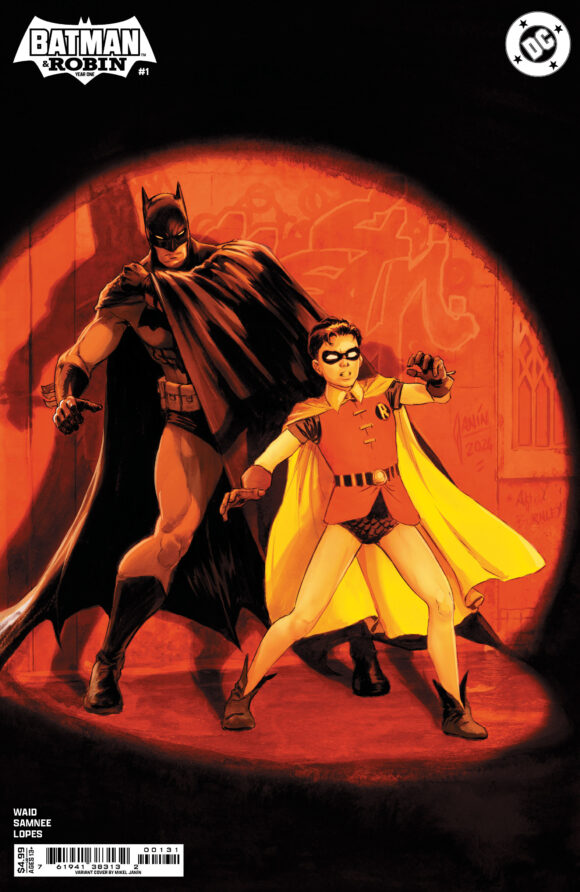
Mikel Janin’s variant for Batman and Robin: Year One #1 pays homage to 1941’s Batman #9.
—
Hey, it’s Batman’s birthday! The Darknight Detective debuted in (as you know) Detective Comics #27, which (as you may or may not know) was released March 30, 1939. This year, we have two groovy features for you: The one below and a companion piece by columnist Jim Beard. Click here to check that baby out because I guarantee you’ll be nodding “yes” as you read along. Dig it. — Dan
—
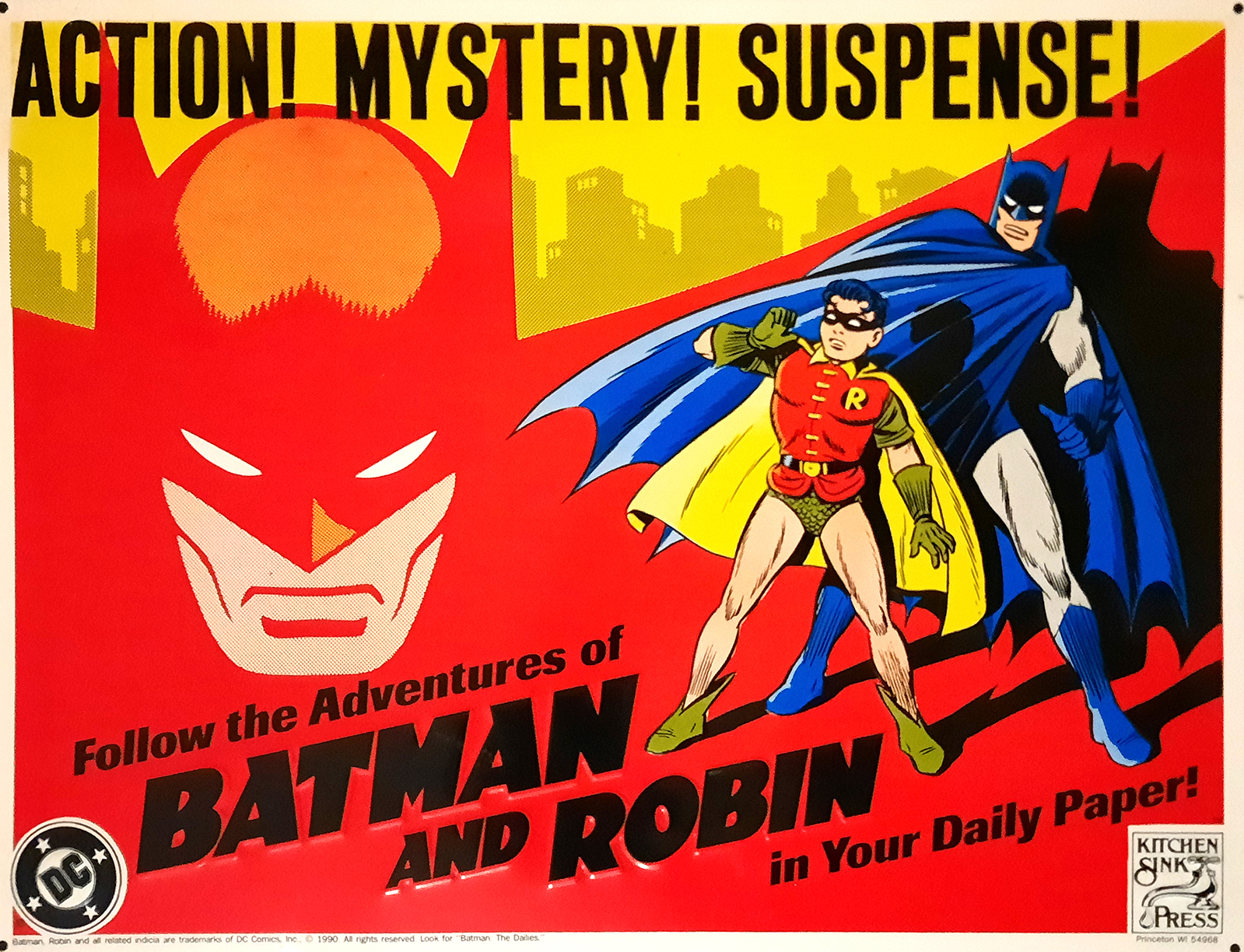
Tin sign promoting DC/Kitchen Sink reprints of the 1940s Batman newspaper comic strip. Art by Peter Poplaski.
By CHRIS FRANKLIN
A while back, author and columnist Jim Beard opined that the 1966 “Best Bat-Wishes” image of the Dynamic Duo perched on a rooftop, poised for action, and drawn by Carmine Infantino and Murphy Anderson, was the greatest image ever created of Batman and Robin. I agree wholeheartedly. But 13th Dimension Commissioner Dan Greenfield tasked me with filling out a list of 12 other images of the Dynamic Duo, nearly as iconic.
As I racked my brain, leafed through my collection and browsed the web, I began to notice something. Many of the most memorable images were thematically similar. In fact, they were very often reinterpretations of previous images, intentional or not. Patterns emerged, and the course of this article took a Bat-turn, parachutes popping out to stop me from spinning.
Rather than feature a single example, I would designate categories of repeating images of Batman and Robin. These iconic visuals may or may not be the original examples of each scenario, but for me, they are the most memorable, and in many cases come to mind before others. Some of these examples may even fall into multiple categories. For this author, these are the most indelible images of comic’s greatest partnership, and they reverberate and reemerge throughout the decades, across all the media the Caped Crusaders have conquered.
—
13. Robin, The Boy Hostage
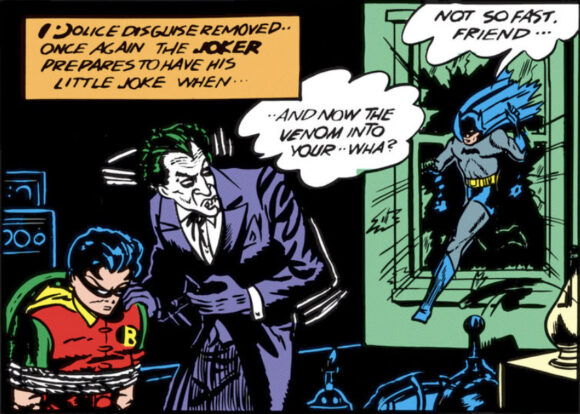
Interior panel from Batman #1, story by Bill Finger, art by Bob Kane and Jerry Robinson
In Frank Miller’s seminal The Dark Knight Returns, Batman jokes to himself about what Two-Face called his young partner,“Robin, The Boy Hostage.” This wasn’t without precedent, dating as far back as the first appearance of the Joker in Batman #1.
If Robin was meant to be the character that co-creators Bill Finger, Bob Kane and Jerry Robinson expected readers to identify with, then being saved by your hero Batman was an example of supreme wish fulfilment. The original creators of the strip mined this often, with Robin all tied up on the covers of Detective Comics #43, 45, 49, 51, 57, 66 and 70.
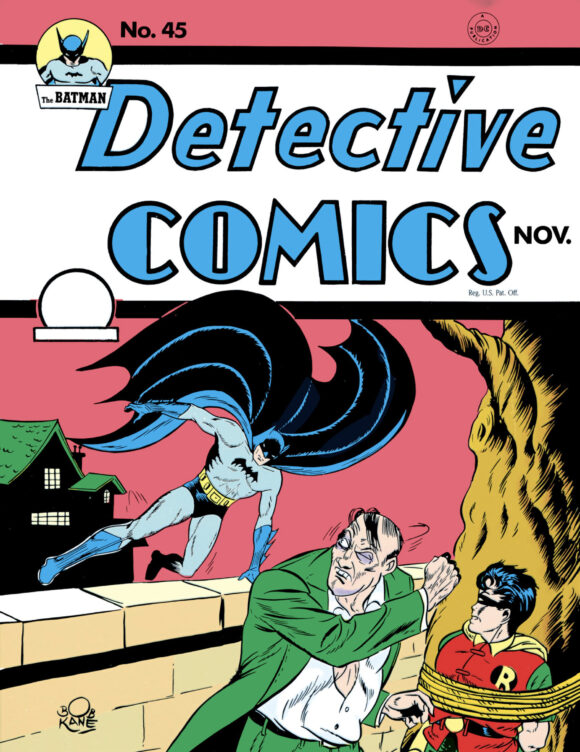
Cover of Detective Comics #45, art by Bob Kane and Jerry Robinson
Despite the Boy Wonder proving his mettle as a worthy partner, this scenario would repeat throughout the decades, and into other media, such as on television, with Burt Ward’s Robin occasionally in solo danger, and Adam West’s Batman racing to save him. Despite a deathtrap befalling our heroes each week, when Robin was singled out, the threat and desperation seemed all the more real.
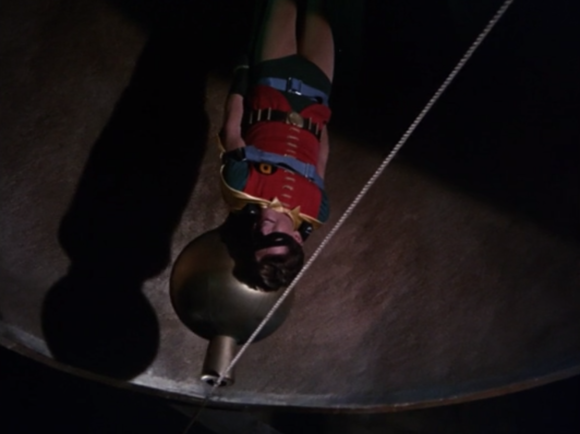
Screen cap from Batman (1966): “The Bookworm Turns”
—
12. The End of the Dynamic Duo?
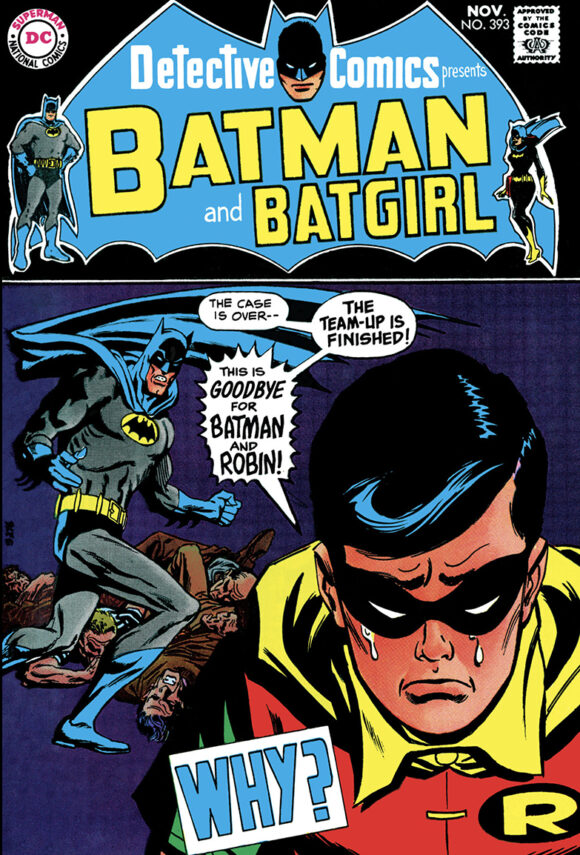
Cover of Detective Comics #393, art by Irv Novick.
They say breaking up is hard to do, and the bond between mentor and protégé, big and younger brother, and father and son that Batman and Robin have shared over their various incarnations has proven a strong one. But that doesn’t mean the threat of a dissolution wasn’t possible, and in some cases, inevitable.
As early as 1943, the Dynamic Duo was nearly destroyed when “Bruce Wayne Loses the Guardianship of Dick Grayson” in Batman #20 (Dec/Jan. 1943). Finger, Kane and Robinson were merely pulling our legs, but 26 years later, it happened for real in Detective #393 (Nov. 1969). On this Irv Novick cover, a sobbing Robin declared “The team-up is over! This is good-bye for Batman and Robin!” In a rare bit of cross-title continuity for the time, in the next issue of Batman (#217), Bruce Wayne sent Dick Grayson off to college, and Batman became a solo act once more.
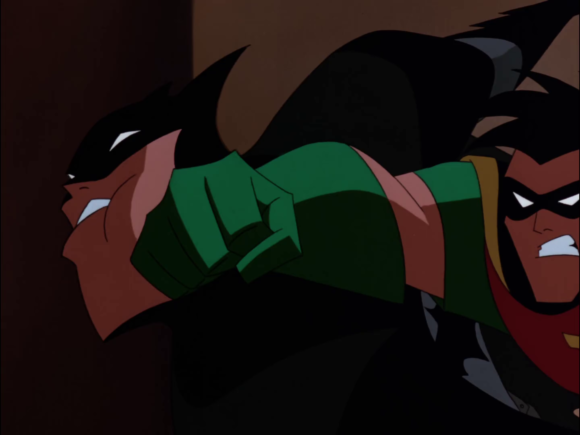
Screen cap from The New Batman Adventures ep “Old Wounds”, courtesy of dcanimated.com
As continuities became varied and convoluted, and histories were rewritten time and again, Bruce and Dick’s split was often less amicable. In the Batman: The Animated Series continuity, Dick Grayson’s grown-up Robin slugs Batman as he rips off his cape and mask, and moves toward his eventual destiny as Nightwing in The New Batman Adventures episode “Old Wounds”. But despite those rough break-ups, an eventual peace is reached between the two, each time. Well, except for the “Imaginary Story” in World’s Finest #153 (Nov. 1965) written by Cary Bates and Edmond Hamilton, with art by Curt Swan and George Klein.
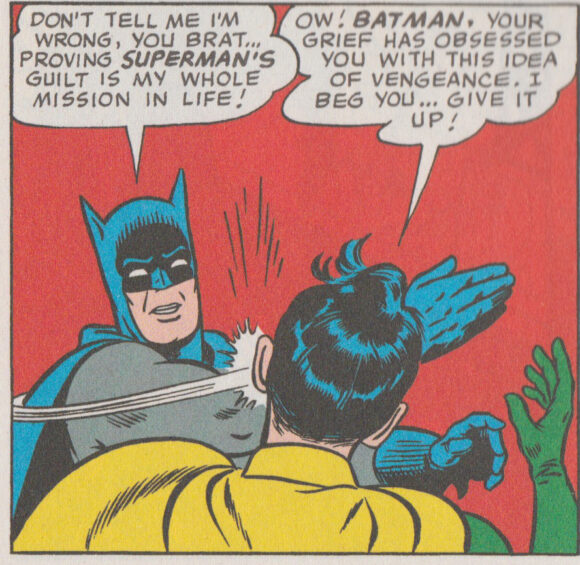
Interior panel from World’s Finest #153. Art by Curt Swan and George Klein.
There Batman is convinced that Superman murdered his father, and when Robin overhears his mentor’s plans to kill the Man of Steel, the Boy Wonder protests. He gets an infamous slap to the face, and then has his memory wiped of ever knowing Batman, and his career as Robin! In all honesty, this single panel, which became one of the earliest, and most prolific memes in the era of social media, is probably the most iconic image of Batman and Robin in today’s cynical age. But I’m not giving it that much credit!
—
11. To the Batcave!
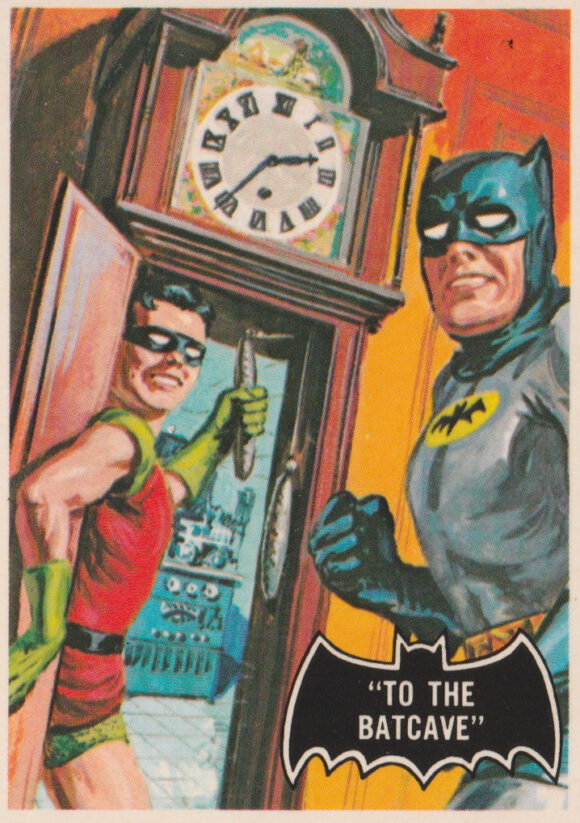
Batman (1966) Topps trading card #39, art by Bob Powell and Norman Saunders
It’s the greatest secret headquarters in all of comics, heck maybe of popular entertainment, period! But part of the allure of the Batcave is how you get to the fortified stronghold deep below the bowels of Wayne Manor. Once the original 1943 Batman movie serial introduced “The Bats Cave,” the comics soon followed suit, and eschewed the old barn and secret rooms Batman and Robin had been known to commiserate in.
Over time, the comics established the secret passage to the stairs leading to the Batcave was behind a grandfather clock, often shown in Bruce Wayne’s study. The 1966 Batman Topps trading card #39 by Bob Powell and Norm Saunders warps space by showing the Batcave’s lab equipment THROUGH the entrance of the clock, but it’s a great image, and you get the idea.
Of course, for millions of fans, the most iconic method of getting from stately Wayne Manor to the Caped Crusaders’ HQ below was the ’60s television series’ Batpoles. Hidden behind a bookshelf in Bruce’s study, the specifically labeled firemen’s poles were revealed when a switch was activated under the head of a Shakespeare bust on Bruce’s desk.
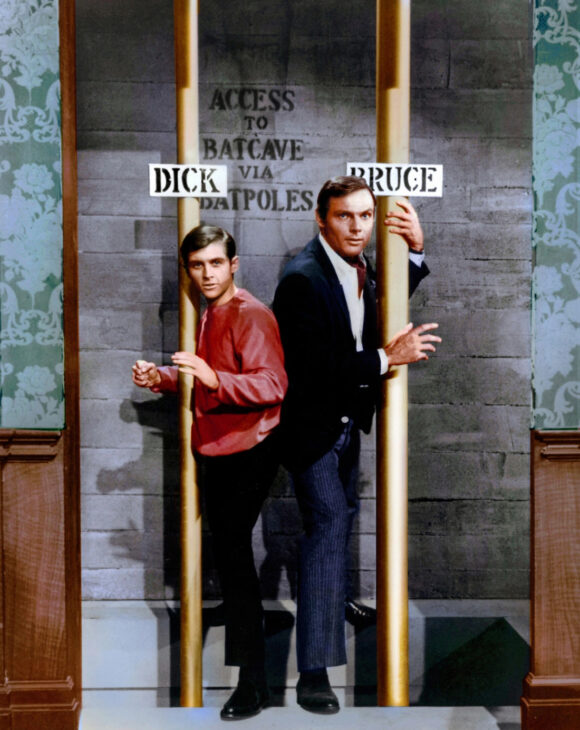
Burt Ward and Adam West in promotional photo from Batman (1966)
How Bruce and Dick emerged in their costumes below remains a mystery, despite the 1966 movie showing us added footage of Bruce throwing a switch mid-drop, and the more recent animated film, Return of the Caped Crusaders, showing the costume elements popping on our heroes as they descend. One of my favorite images of the heroes sliding down the Bat-Poles is from the children’s book, Batman: From Alfred to Zowie, by Ruthanna Thomas and Tom Gill.
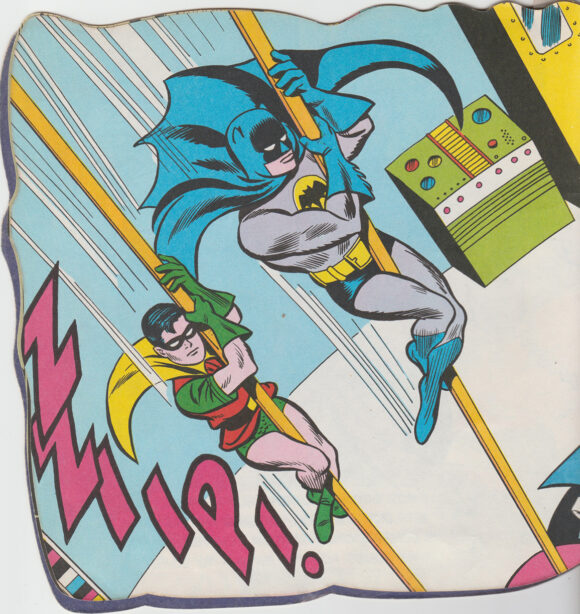
From Batman: Alfred to Zowie, art by Tom Gill
—
10. SOCK! POW! ZOK!
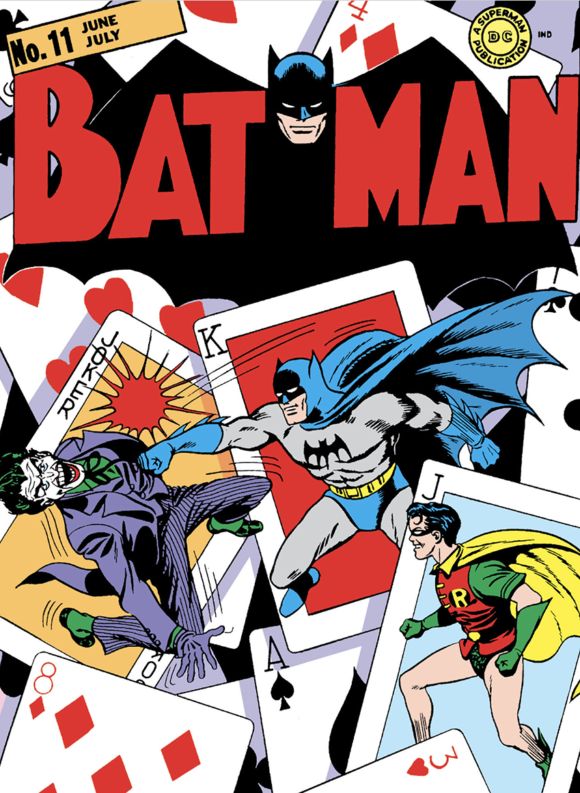
Batman #11 cover, art by Fred Ray
Batman may have been a sleuth and starred in Detective Comics, but that didn’t mean he fought crime with his brains alone. No, he and the Boy Wonder have often been shown throwing hands at whatever foes they encountered. As early as the cover of Batman #2 (Summer 1940), Kane and Robinson depict Batman pushing a crook over a kneeling Robin. A few issues later, #7 has Batman slugging a goon while Robin tackles him.
One of the most famous slobber knockers captured on a Golden Age comic was Batman pasting the Joker amid an oversized deck of playing cards while Robin gleefully observed, on Fred Ray’s cover of Batman #11 (Jun./July 1942). Like many iconic images on this list, the ’60s television series cemented the importance of the “Bat-fight” in the animated opening credits.
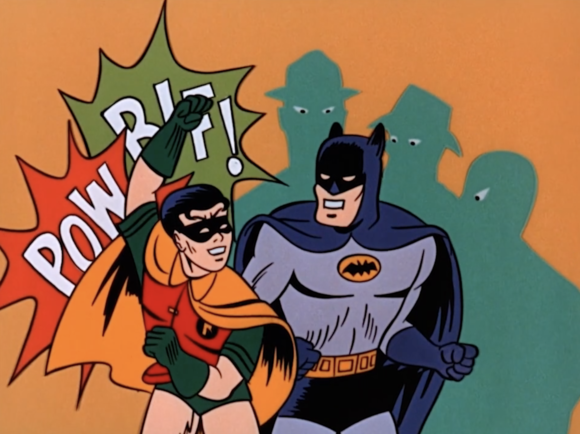
Screen cap from opening title sequence of Batman (1966)
Each episode delivered on that promise, with at least one live-action battle breaking out per episode, with onomatopoeias flying! In comic form, perhaps this was never quite as well captured as Alex Ross’ masterful cover for Batman #682 (January 2009) a flashback to the Dynamic Duo’s salad days, as they seemingly punched their entire rogues’ gallery at once!
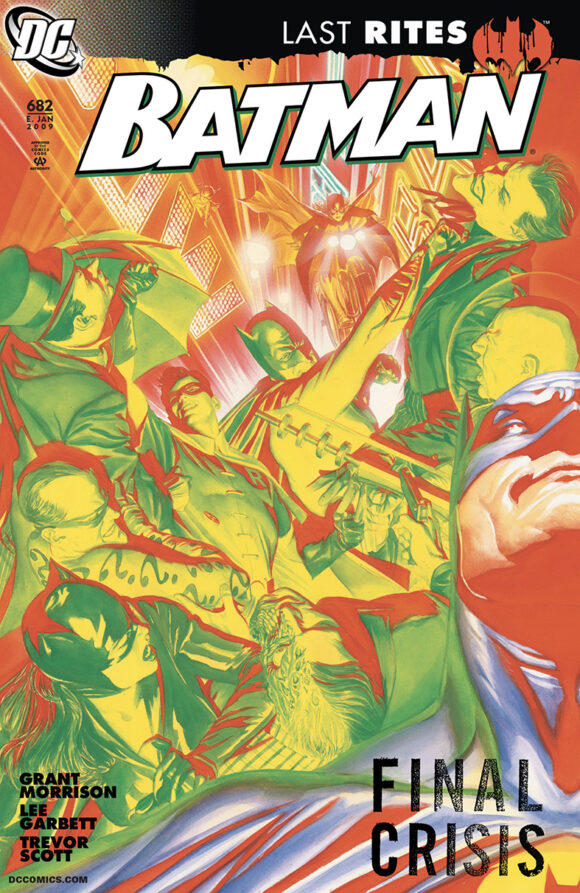
Cover of Batman #682, art by Alex Ross
—
9. A Death in the Family
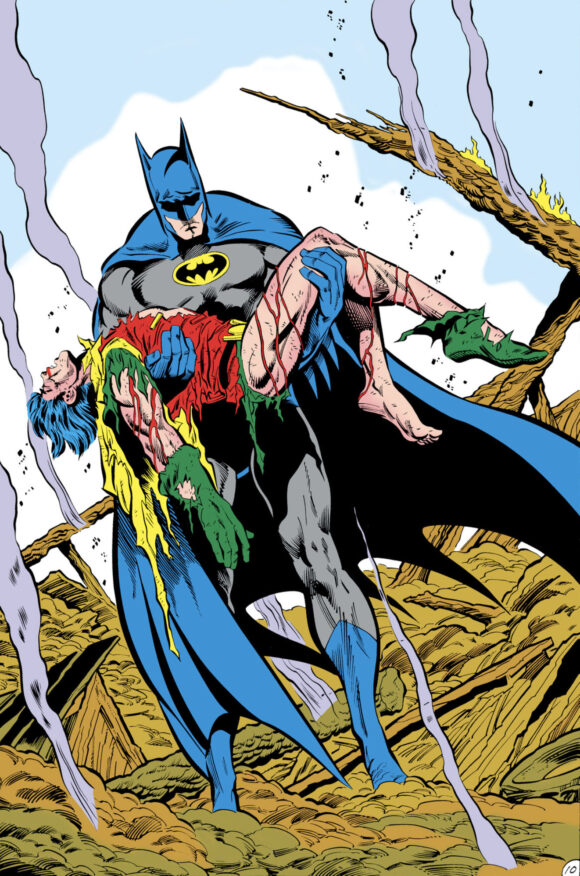
Splash page from Batman #428, art by Jim Aparo and Mike DeCarlo
As previously established, Robin was often the hostage of his and Batman’s foes, and the threat of an untimely demise for the young hero hung over the series for decades. Fondly remembered as a somber story in an era of sci-fi hijinks, Sheldon Moldoff’s masterpiece cover for Batman #156 (June 1963) shows a teary-eyed Batman carrying the body of his lifeless partner across the terrain of an alien planet.
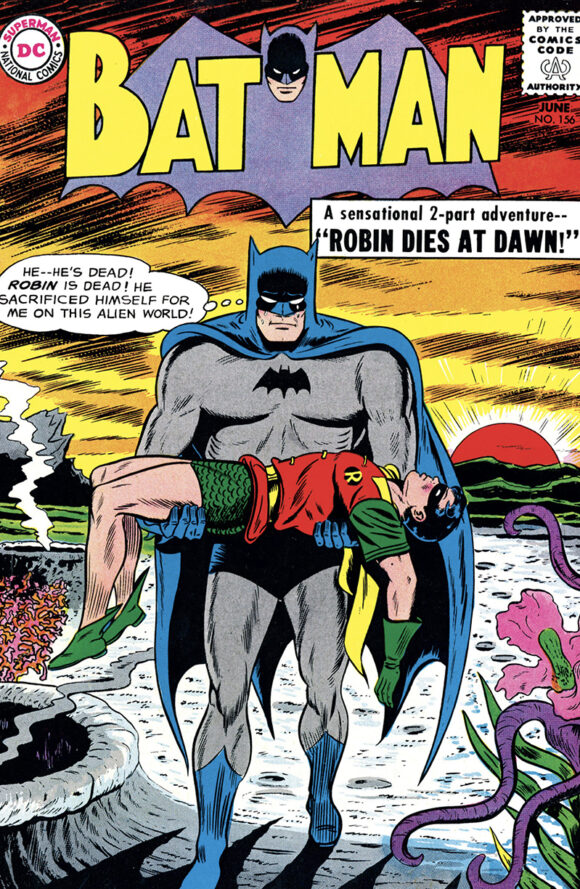
Cover to Batman #156, art by Sheldon Moldoff
Legendary comics pioneer Neal Adams had several occasions to show us a seemingly dying or dead Teen Wonder, but none is more powerful than Limited Collectors’ Edition #C-51, with Robin’s body front and center, and an anguished Batman screaming behind him, as Ra’s Al Ghul’s spirit leers in the background. But of course, all of those were fake-outs.
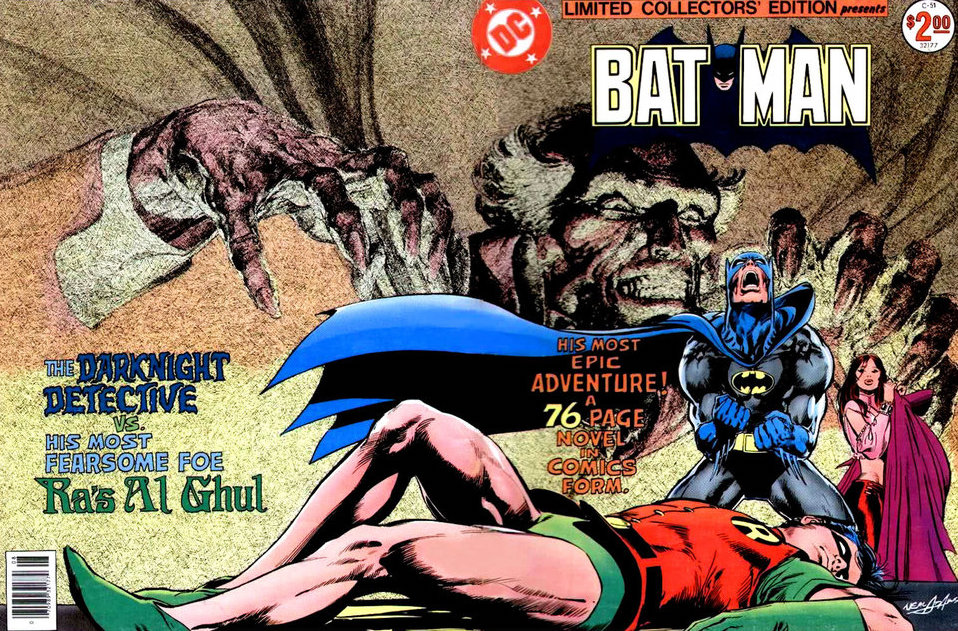
Cover to Limited Collectors’ Edition #C-51, art by Neal Adams
In 1988, thanks to a controversial telephone stunt and some bloodthirsty fans, it became all too real in Batman #428 (1988), where the second Robin, Jason Todd, is first beaten then blown up by the Joker. Jim Aparo’s and Mike DeCarlo’s powerful image of a defeated Batman holding the bloody and battered corpse of his protégé is one of the most powerful of the character’s career, despite recent years undoing the once seemingly permanent death.
—
8. Well Done, Ol’ Chum
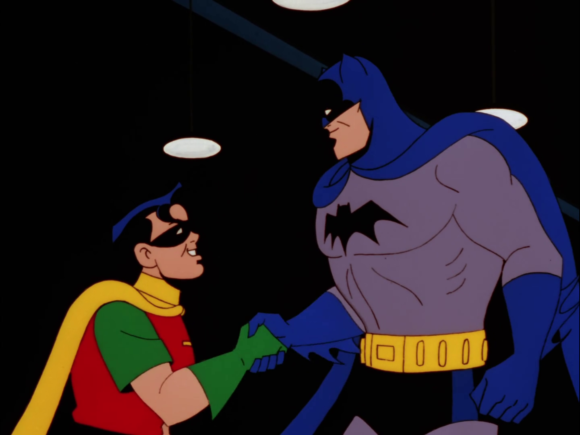
Screen cap from The New Batman Adventures ep “Legends of the Dark Knight”, courtesy of dcanimated.com
What better way for a mentor to show his charge they approve of their work than a heartfelt hand on the shoulder, or a hearty handshake?
At the end of Robin’s very first story in Detective Comics #38 (April 1940), Finger, Kane and Robinson depict Bruce Wayne putting his hand on Dick’s shoulder as he asks him if he’s going back to the circus, now that his parents’ murder has been avenged. A smiling Grayson says his mom and dad would want him to carry on fighting crime, plus, he loves the adventure! This shot of an approving Batman, and smiling Robin would repeat through the decades, often with the two clasping hands, having vanquished whatever foes they just encountered.
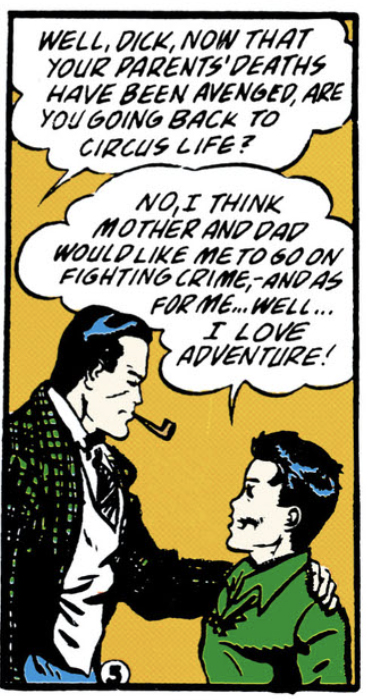
Interior panel from Detective Comics #38, story by Bill Finger, art by Bob Kane and Jerry Robinson
The animated title sequence to the ’60s television series comes to mind, as does the tribute to it in the wonderful New Batman Adventures episode “Legends of the Dark Knight,” where the Golden Age Dynamic Duo celebrate their defeat of the Joker. In live-action, Val Kilmer’s Batman and Chris O’Donnell’s Robin shake on the founding of their partnership in a memorable moment in Batman Forever.
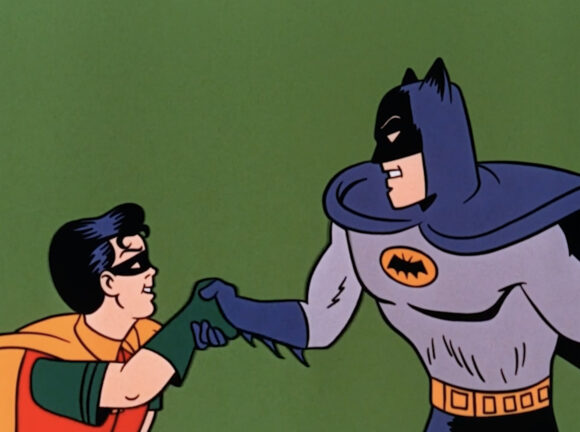
Screen cap from opening title sequence of Batman (1966)
—
7. Sensational Character-Find
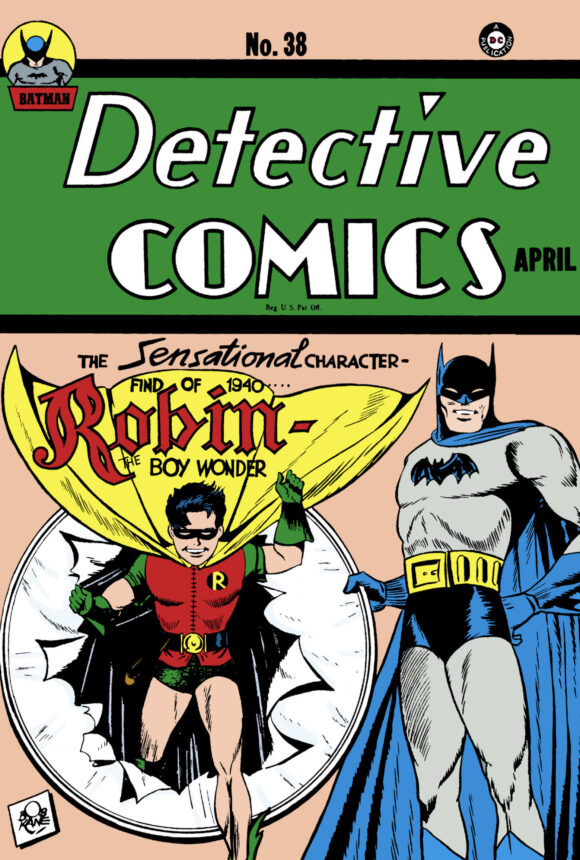
Cover to Detective Comics #38, art by Bob Kane and Jerry Robinson
The introduction of Robin in Detective Comics #38 caused a seismic shift in not only the Batman strip, but also the burgeoning comic industry. Robin begat a legion of kid sidekicks, from the memorable (Bucky, Speedy) to the now obscure (Mr. Scarlet’s Pinky, for example). Batman proudly introduced us to Dick Grayson’s crimefighting persona as he held a circus hoop for the boy to dramatically leap through. But there have been many Robins, and each one was introduced with style.
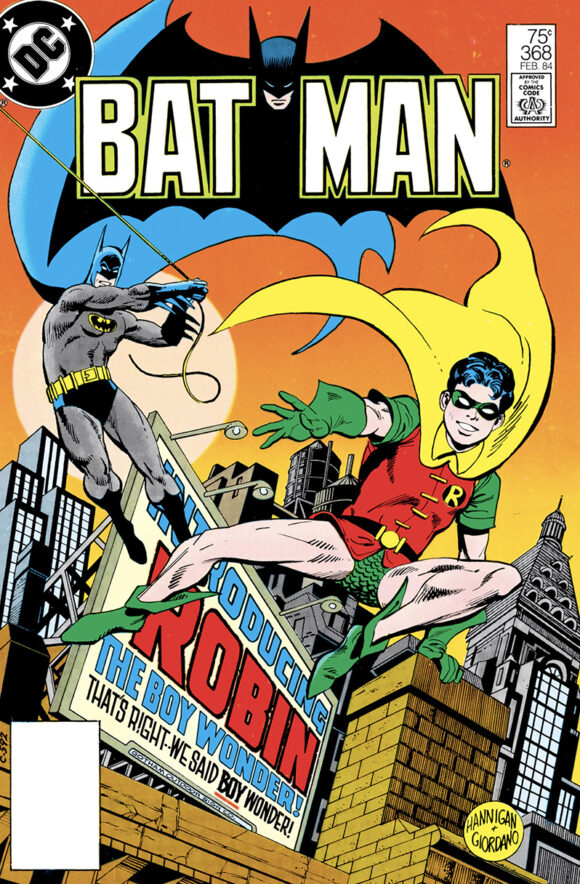
Batman #368 cover by Ed Hannigan and Dick Giordano
Jason Todd got the official OK to wear the Robin costume on Ed Hannigan and Dick Giordano’s cover for Batman #368 (Feb. 1984). He leaped toward the readers, with a billboard announcing his arrival (“That’s Right–We Said BOY Wonder”), with Batman swinging approvingly in the background. Tim Drake had no less than two introductions, swinging into the Bat-Signal, briefly wearing the traditional Robin costume on George Perez’s cover to Batman #442 (1989), and then donning his Neal Adams-designed upgrade in Norm Breyfogle and Steve Mitchell’s interior pages for Batman #457 (Dec. 1990).
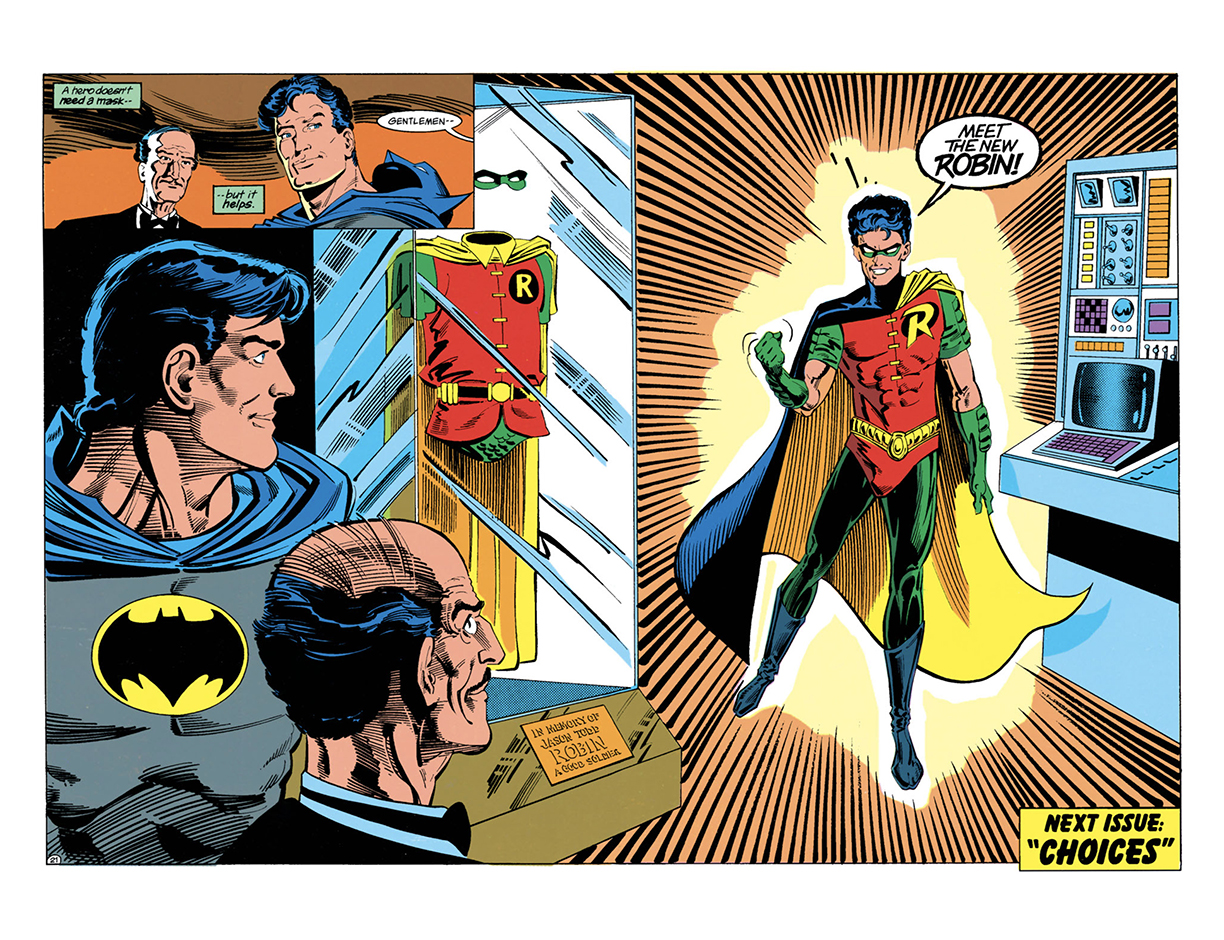
Interior double-page spread from Batman #457, story by Alan Grant, art by Norm Breyfogle and Steve Mitchell
—
6. Atomic Batteries to Power, Turbines to Speed
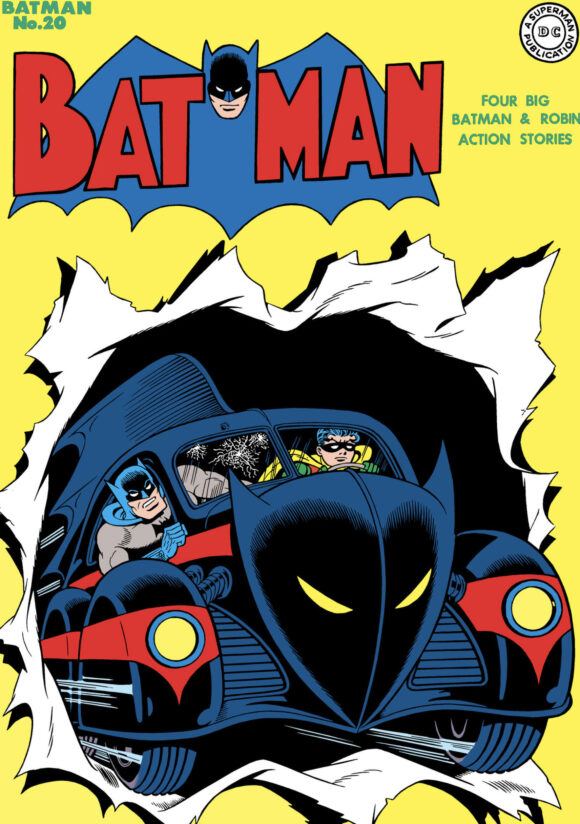
Cover to Batman #20, art by Dick Sprang
What Bat-fan hasn’t longed to hop into fiction’s greatest car, and roar out into the night? The Batmobile has proved to be more essential to the general public’s perception of the Batman mythos than Robin himself, having appeared in every live-action iteration, while the Boy Wonder is often sidelined.
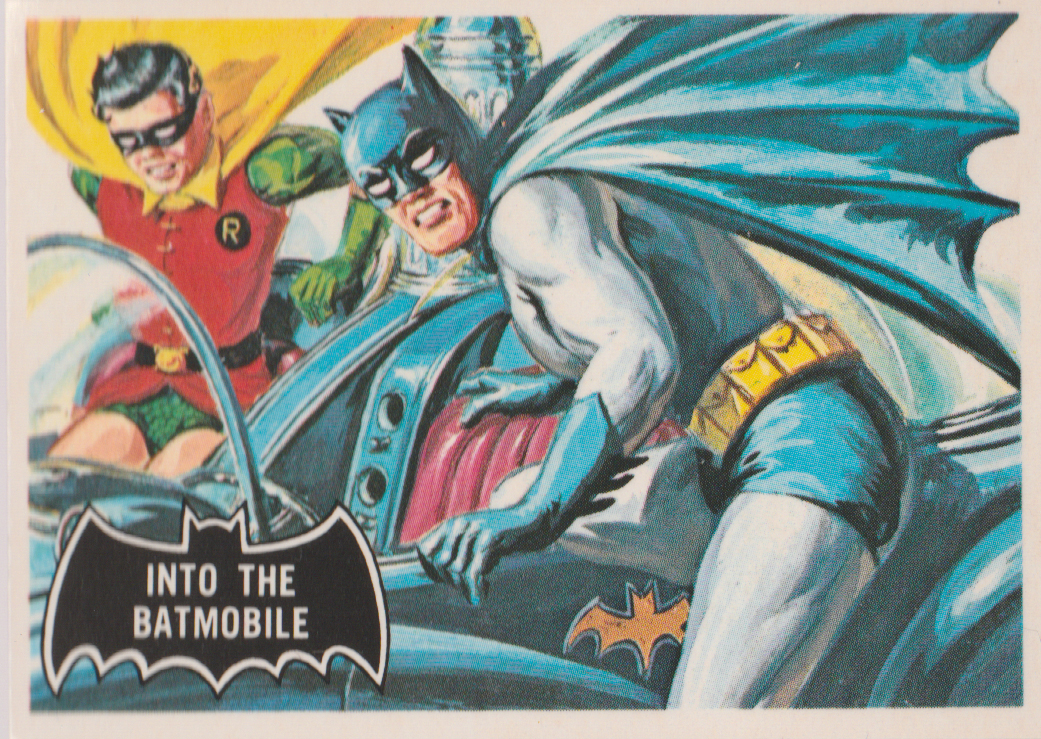
Batman (1966) Topps trading card #8, art by Bob Powell and Norman Saunders
But whether they are leaping into it, as in the Topps card #8, “Into the Batmobile” by Powell and Saunders, or rocketing off from Bronson Canyon as in the ’60s television series, the Dynamic Duo in that car means excitement and danger await. How many times have kids uttered Burt Ward’s deathless lines when getting into their OWN parent’s car? “Atomic batteries to power, turbines to speed” was something I often said when my Dad and I were on a special mission to the auto parts store, or on a fishing trip.
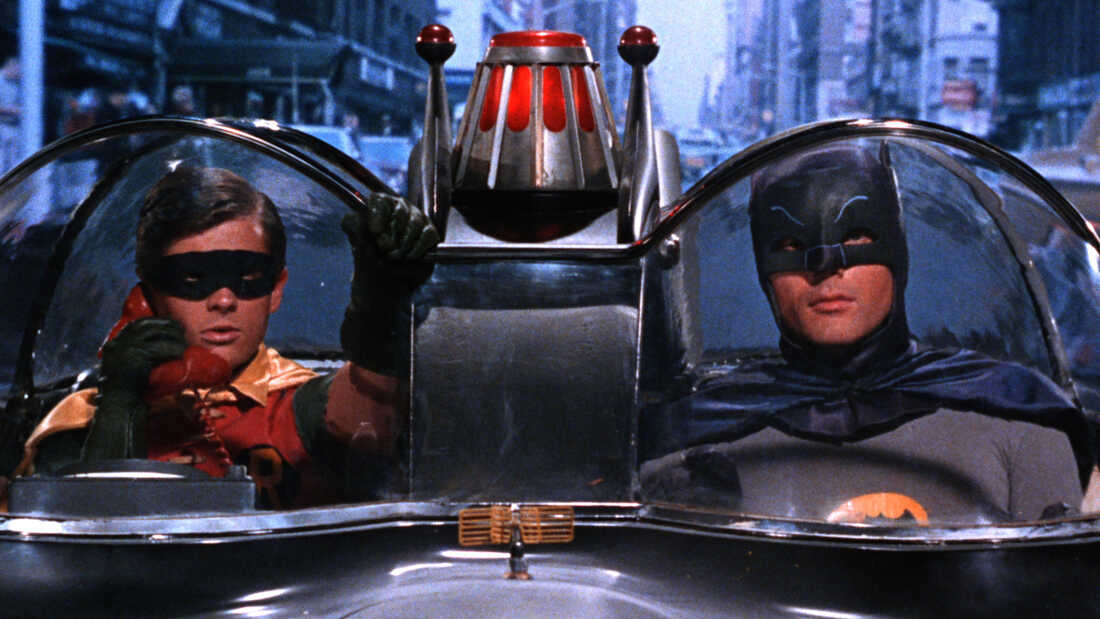
Scene from Batman (1966) featuring Burt Ward and Adam West
Surprisingly some of the most iconic images of the heroes in the Batmobile has Robin taking the wheel, while Batman rides shotgun, ready to leap into action. Jose Luis Garcia-Lopez drew several images like this, first for the comic mini-series The Untold Legend of the Batman #2 (Aug. 1980) and the 1982 DC Style Guide, used by licensees for their products.
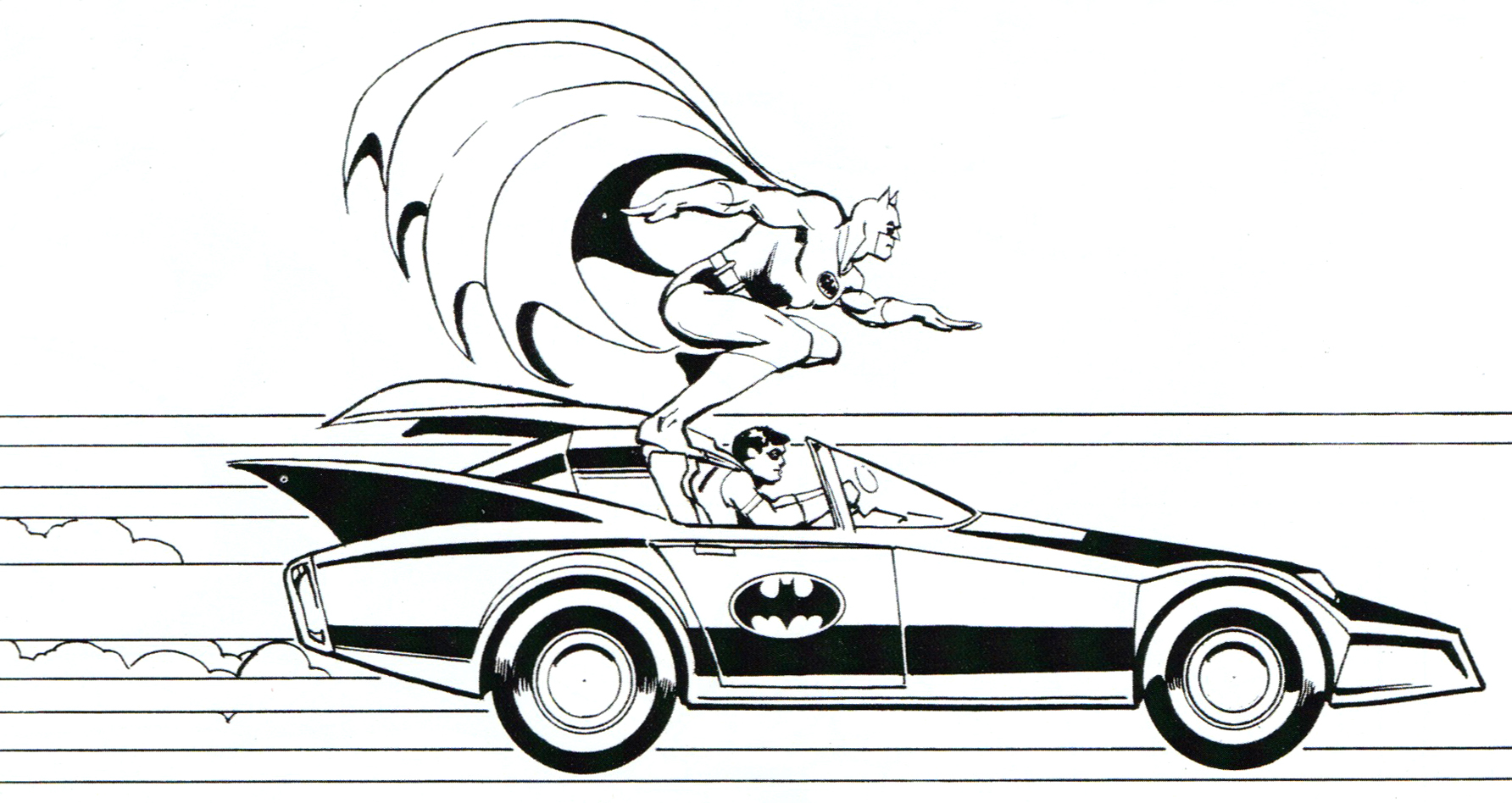
Art from 1982 DC Style Guide by Jose Luis Garcia Lopez and Dick Giordano
The most famous example of this is the Batmobile’s greatest cover appearance, literally bursting through the pages of Batman #20, (Dec./Jan. 1943). Dick Sprang depicts an underage Robin piloting the powerful, bat-headed sedan with grim determination, peering through the bullet shattered windshield as Batman readies his jump from the passenger door.
—
5. Best Bat-Wishes, or Standing Ovation
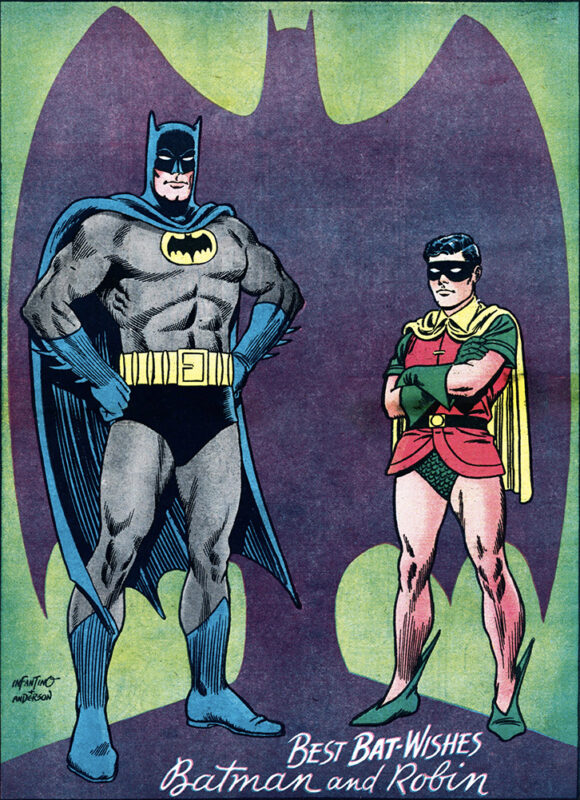
Centerfold pin-up from Batman #181, art by Carmine Infantino and Murphy Anderson
How exciting can it be for your heroes to just stand around? Well, when those heroes are visually stunning like Batman and Robin, the answer is… a lot! On the back cover of Batman #1, no less, a smiling Dynamic Duo paused for a snapshot. Batman’s hands were at his waist, and Robin’s arms were folded. They even “autographed” it and instructed a legion of youngsters to “cut out and frame” this souvenir, ensuring their family fortunes would eventually be far less than they could have been!
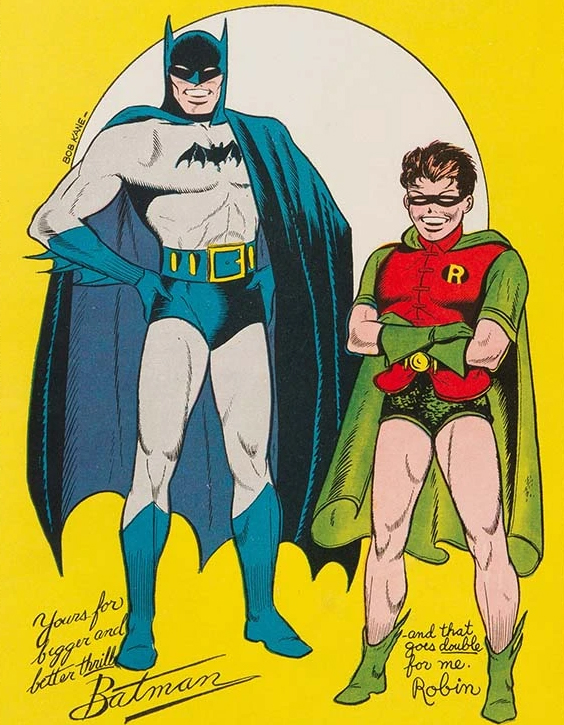
Batman #1 back cover pin-up, art by Bob Kane and Jerry Robinson
Flash forward 26 years, and nearly the same pose is recreated in double-page pin-up form by Carmine Infantino and Murphy Anderson for Batman #181 (June 1986), and also available as a pin-up in a series advertised in DC that year. This time the duo isn’t smiling, however, despite saluting their readers with “Best Bat-Wishes.” These stern looking images of our heroes would become the standard static pose of each of them for the next decade and a half, appearing on comic covers, toys, clothing and any piece of merchandising you can think of.
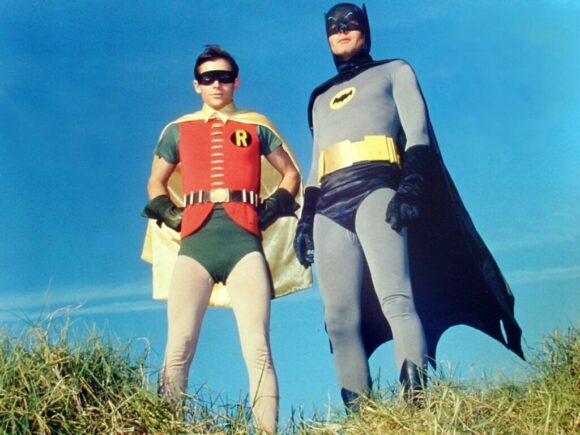
Promotional shot of Burt Ward and Adam West from the Batman (1966) TV series
Meanwhile, their live-action counterparts, Adam West and Burt Ward proved they were outstanding in their field with a memorable photoshoot to promote the explosively popular TV series. Artist Frank Quitely knew the power of this static but grandiose visual, giving us a new Dynamic Duo in the form of Dick (Batman) Grayson and Damian (Robin) Wayne on the cover of Batman and Robin #1 (Aug. 2009).
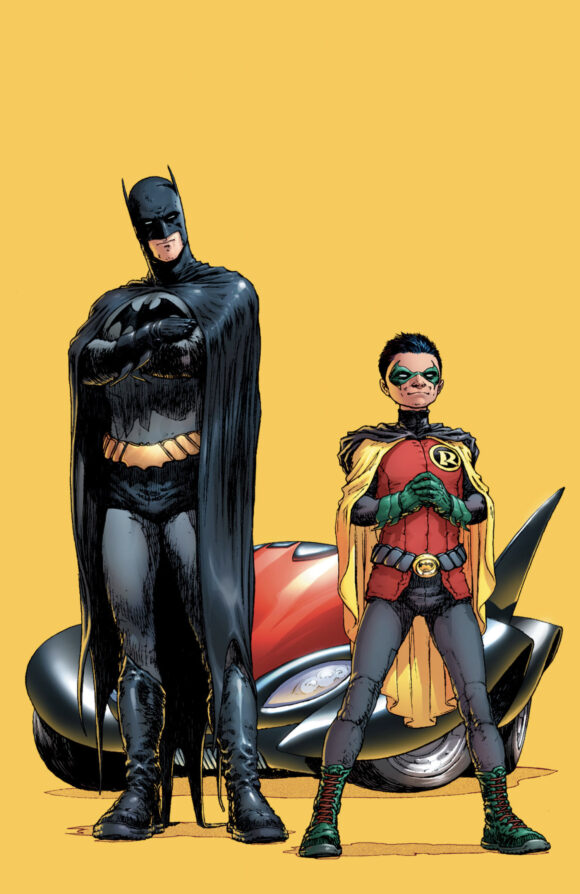
Batman and Robin #1 cover, art by Frank Quitely
—
4. Running Into Adventure
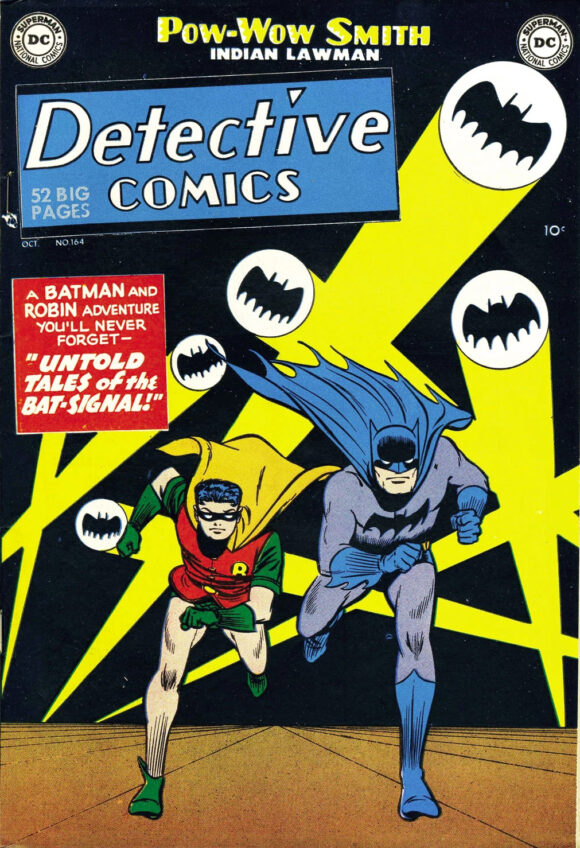
Detective Comics #164 cover, art by Winslow Mortimer and George Roussos
The Dynamic Duo’s mission is an urgent one, and they are often called upon to sprint from one dangerous locale to another. They race into action to follow the trail of the Joker in Batman #1, and Kane and Robinson break convention by showing Batman’s cape and foot outside the panel borders, adding a level of dynamism. A few issues later, our heroes are running straight at us from the solid black cover of Batman #3 (Fall 1940), once again by Kane and Robinson.
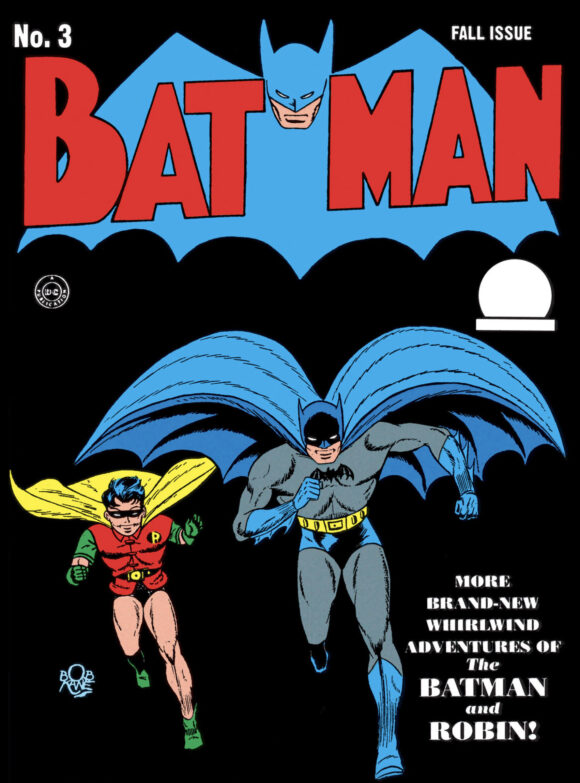
Cover to Batman #3, art by Bob Kane and Jerry Robinson
A decade passes, and Batman and Robin are running in front of multiple Bat-Signal beams on Win Mortimer and George Roussos’ iconic cover for Detective Comics #164 (Oct. 1950). Of course, the 1966 Batman TV series began every episode with an animated version of the Caped Crusaders running right at us.
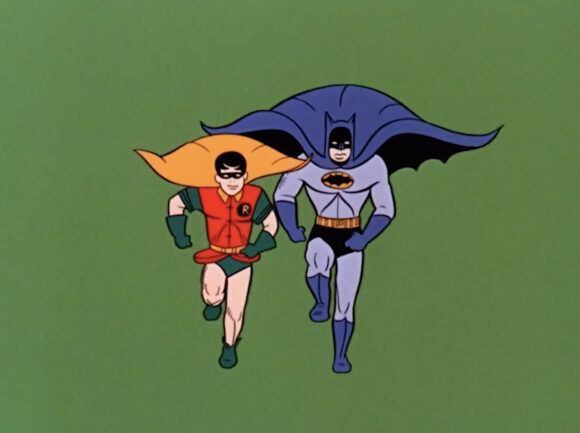
Screen cap from opening title sequence of Batman (1966)
Adam West and Burt Ward jogged across Gotham (or was it New York?) in a memorable scene in the 1966 Batman film, which is often seen floating around social media as a gif. Images of the Masked Manhunters running were prolific on merchandise, from ’60s images by Carmine Infantino, to ’80s Style Guide shots by Jose Luis Garcia-Lopez. The partnership of the newly forged Dynamic Duo was cemented by showing Val Kilmer and Chris O’Donnell running in front of the Batsignal, right toward the viewers at the end of the film Batman Forever.
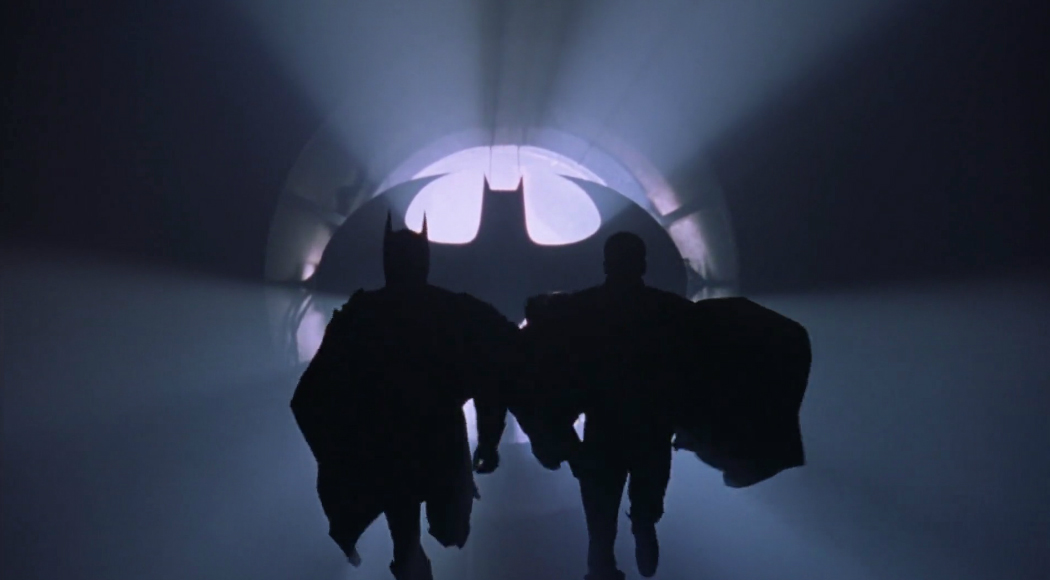
Screen cap from end sequence of Batman Forever
—
3. Just a Swingin’
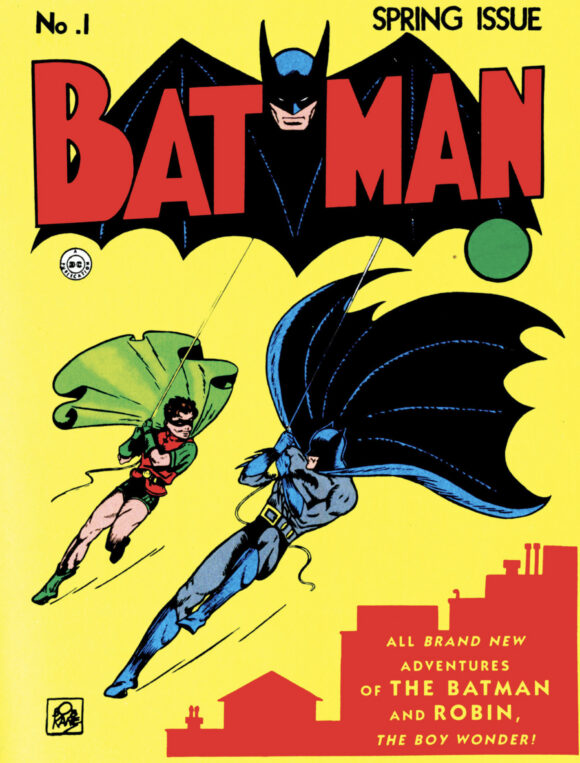
Batman #1 cover, art by Bob Kane
How iconic is Batman #1? Well, just look how many times it’s referenced on this list. But there’s nothing more iconic about it (OK, except the introduction of the Joker and Catwoman to the mythos and pop culture) than the cover by Bob Kane, depicting a happy Batman and Robin swinging above a silhouetted red cityscape, against a yellow sky.
The Dynamic Duo couldn’t fly like many other superheroes, but they sure could swing, and we could too, if we had a rope and a strong tree branch handy. The “Batrope” is probably the heroes’ most prolific conveyance, even more so than the Batmobile, appearing in nearly every story over the past eight decades.
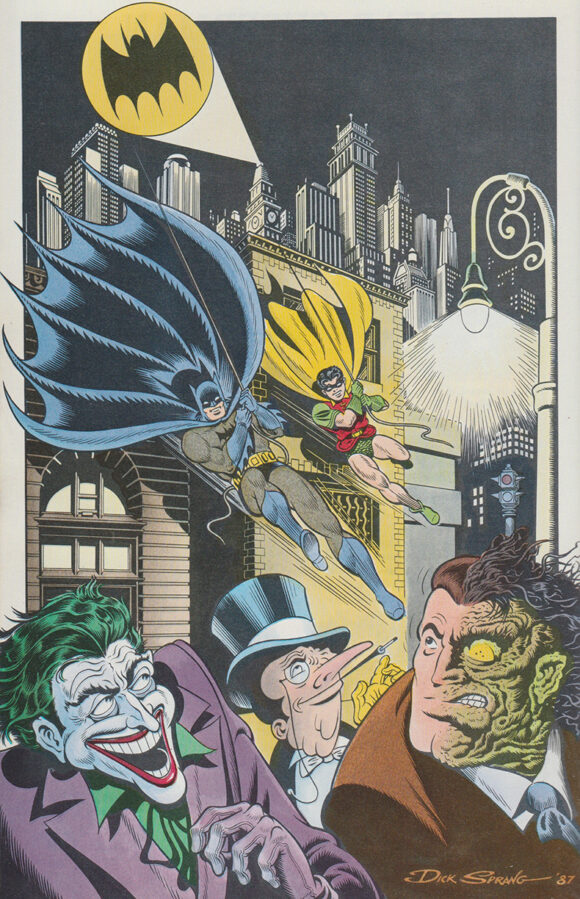
Page from The History of the DC Universe hardcover, art by Dick Sprang, colors by Bill Wray
Curt Swan and Charles Paris gave us another swinging duo on the cover of another first issue, for the one-shot 3-D Batman in 1953. This image was reused for a lot of ’60s Batman merchandise, as was the cover image of the 1966 reprint of that issue, drawn by Carmine Infantino and Murphy Anderson, and redrawn for a bevy of Mego Batman products in the 1970s. Dick Sprang often homaged the original cover image, as in the hardcover collection of The History of the DC Universe.
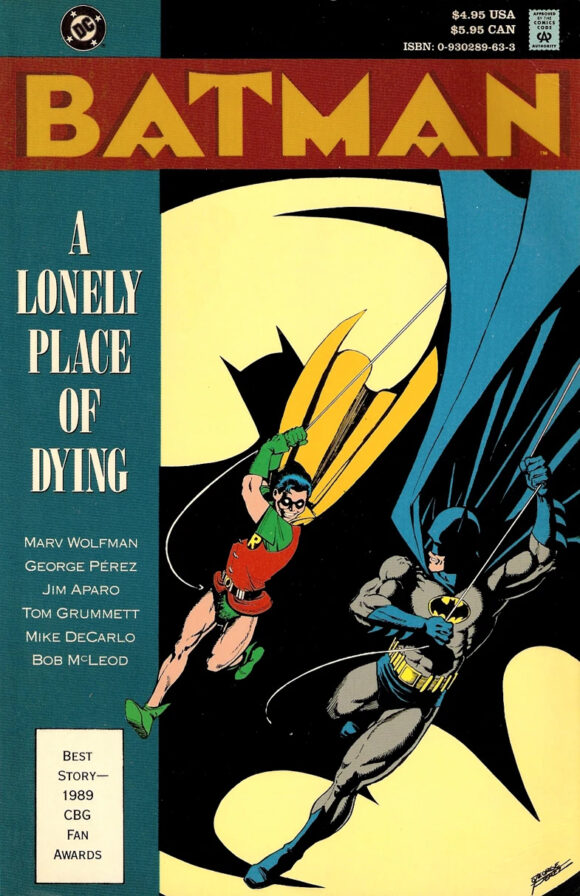
Batman: A Lonely Place of Dying trade paperback cover, art by George Perez
George Perez put his own indelible spin on it on the cover of the trade paperback of A Lonely Place of Dying, introducing us to future Robin, Tim Drake. Not quite a copy, but a spiritual homage is the full-page splash of Batman and his new Robin, Carrie Kelley, leaping through the sky in Book 3 of The Dark Knight Returns by Frank Miller, Klaus Janson and Lynn Varley.
—
2. In the Spotlight
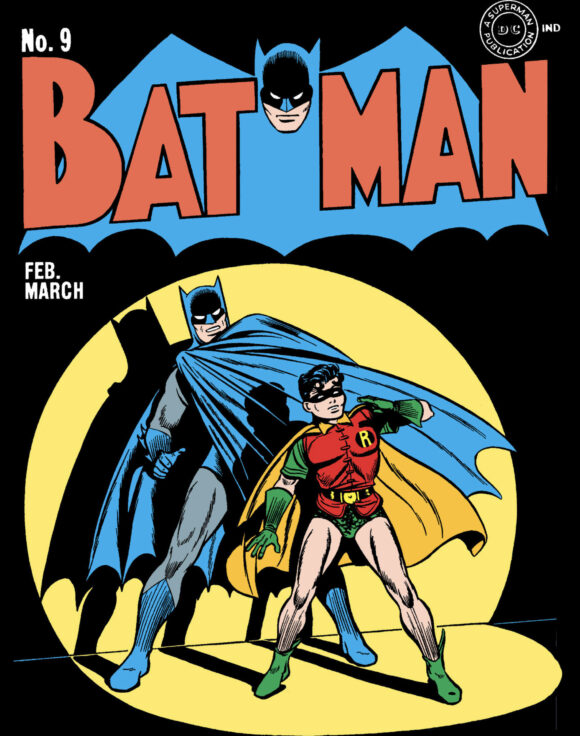
Batman #9 cover, art by Jack Burnley
Is this the most memorable image of Batman and Robin from comic’s Golden Age? Hailing originally from the cover of Batman #9 (Feb./Mar. 1942), Jack Burnley depicts our heroes caught in a yellow spotlight against a solid black wall. Batman is pulling his cape in front of him, while Robin puts his hand up to shield his eyes. Nothing says noirish danger like this image, and the folks at National/DC knew it, reusing the image seven issues later for the cover of #16, but this time flipping it, and having a shadowy thug throwing a flashlight on the duo.
There was very little Batman merchandise in the 1940s, but this pose was recycled for just about every piece of it, from promotional materials for the Batman newspaper comic strip (which Burnley was heavily involved in) to a rare set of Batman decals.
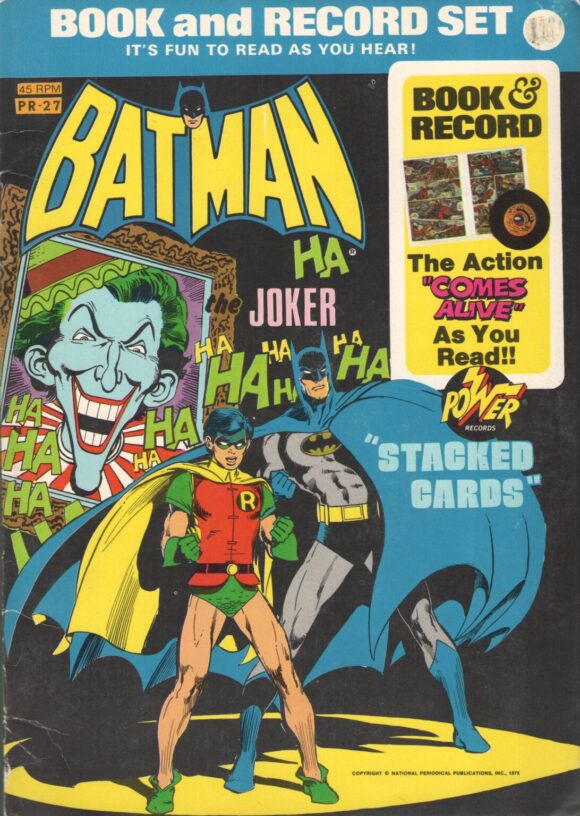
Power Records #PR-27 cover, art by Neal Adams
Later creators saw the power of this image, with Neal Adams and Dick Giordano riffing on it for the cover of Power Records comic #PR-27 “Stacked Cards/Trumping the Joker” and Adams again, this time with Bernie Wrightson for the cover of the tabloid treasury comic Limited Collectors’ Edition #C-59, “Batman’s Strangest Cases.”
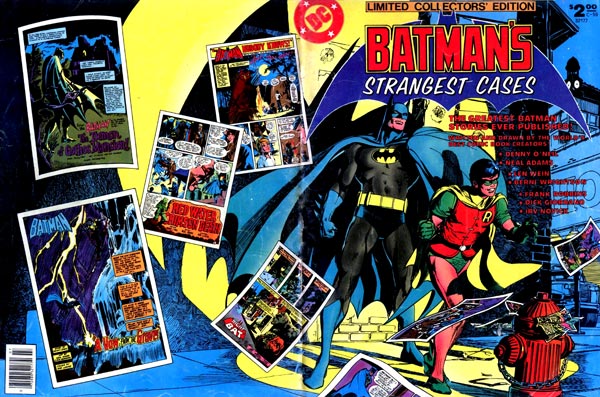
Cover to Limited Collectors’ Edition #C-59, art by Neal Adams and Berni Wrightson
Artist Alex Ross faithfully copied Burnley’s original composition in his own inimitable style for Les Daniels’ 1999 hardcover Batman: The Complete History. One of my favorite items in my collection is a tin sign issued in the early ’90s to promote DC and Kitchen Sink Press’ reprints of the 1940s Batman newspaper strips. Artist Peter Poplaski effortlessly recreated Burnley’s style on this striking piece of wall art.
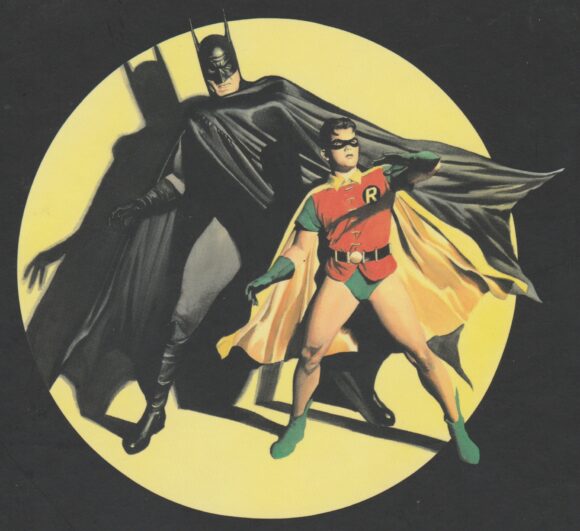
Batman: The Complete History, back cover art by Alex Ross
—
1. Best Bat-Wishes, or Up on the Roof
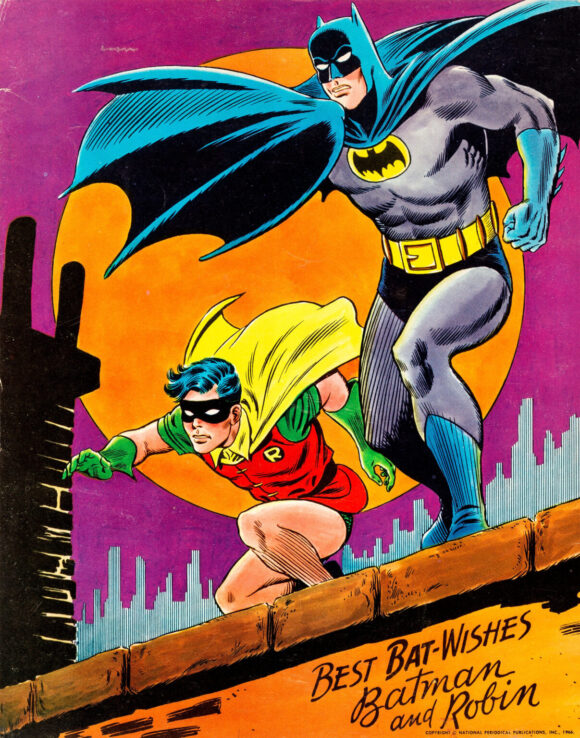
Centerfold pin-up from Detective Comics #352, art by Carmine Infantino and Murphy Anderson
And finally, we finish where we started, back to the pre-selected most iconic image of Batman and Robin, perched on that roof by Infantino and Anderson, from either the centerfold of Detective Comics #352 (June 1966) or that set of pin-ups advertised in DC Comics that same year. What’s left to say about this image that Jim Beard and Dan Greenfield haven’t already said?
Well, for me, I think one of the reason’s this image resonates so, is because it both harkens to the darker, more mysterioso Golden Age era of Batman, and also looks ahead to the Darknight Detective era that is soon to follow. It still fits in with Batman’s most popular, Silver Age era, but is timeless as well. Another is the kinetic energy in this static shot. There’s a sense of movement, of coiled muscles in this image that few others have captured. Leave it to the co-creator of the Silver Age Flash to be a master of showing still characters in motion, ably abetted by Anderson’s lush brushwork.
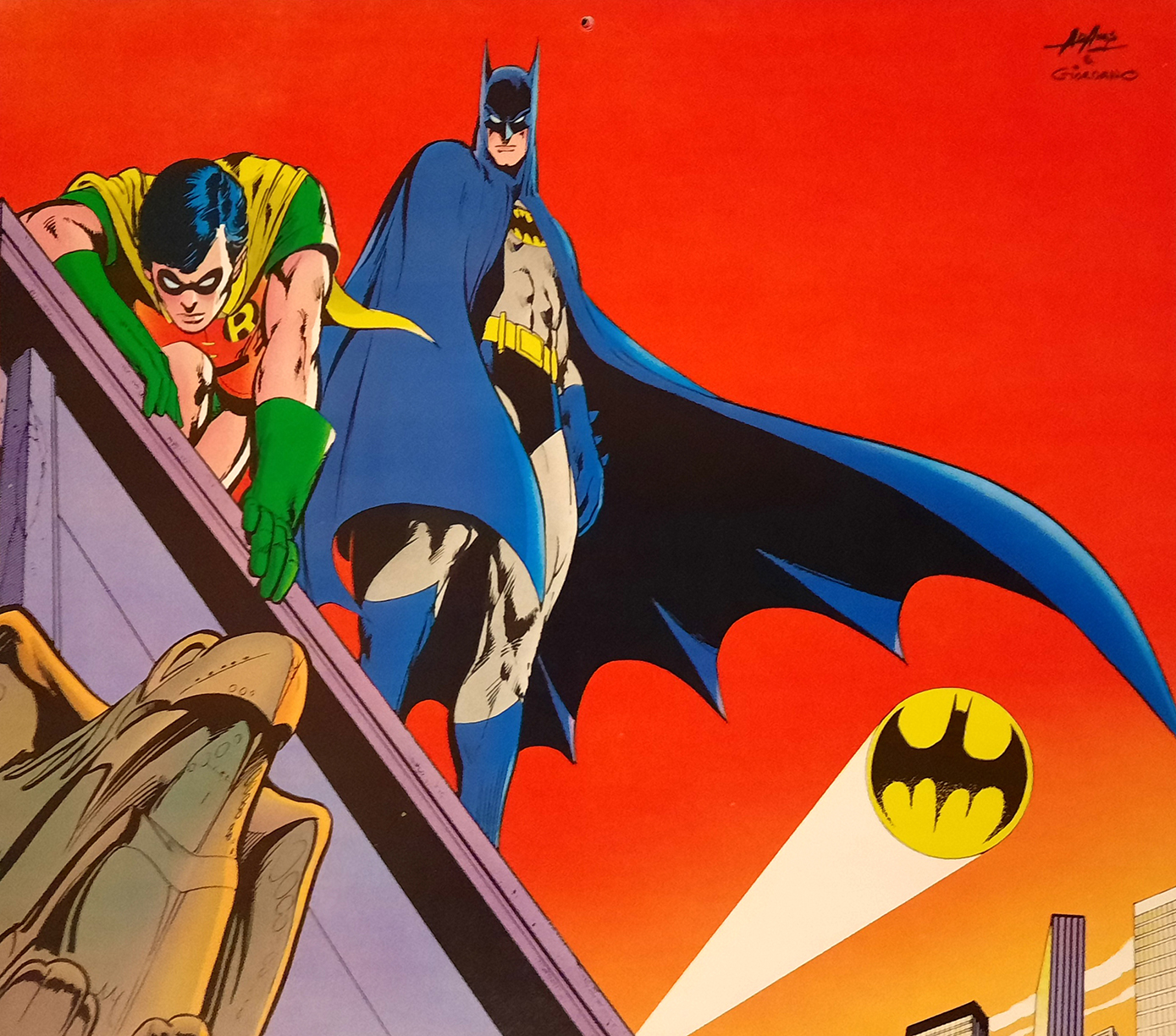
Art from Super DC Calendar: 1976 by Neal Adams and Dick Giordano
Other top artists knew something great when they saw it. Aside from all the direct homages and swipes Jim showcased here on 13th Dimension, other Bat-masters reinterpreted the image as their own. Neal Adams and Dick Giordano gave us an even more brooding take on it for a page in the 1976 Super DC Calendar. Marshall Rogers and Terry Austin combined this image with the one above, and had Batman throwing his cape in front of his face, while Robin leaned over a skyscraper ledge, perched to pounce on the Penguin in Detective Comics #473 (Nov. 1977). Rogers later recreated this image for a special bonus plate in his early 1980s Batman Portfolio.
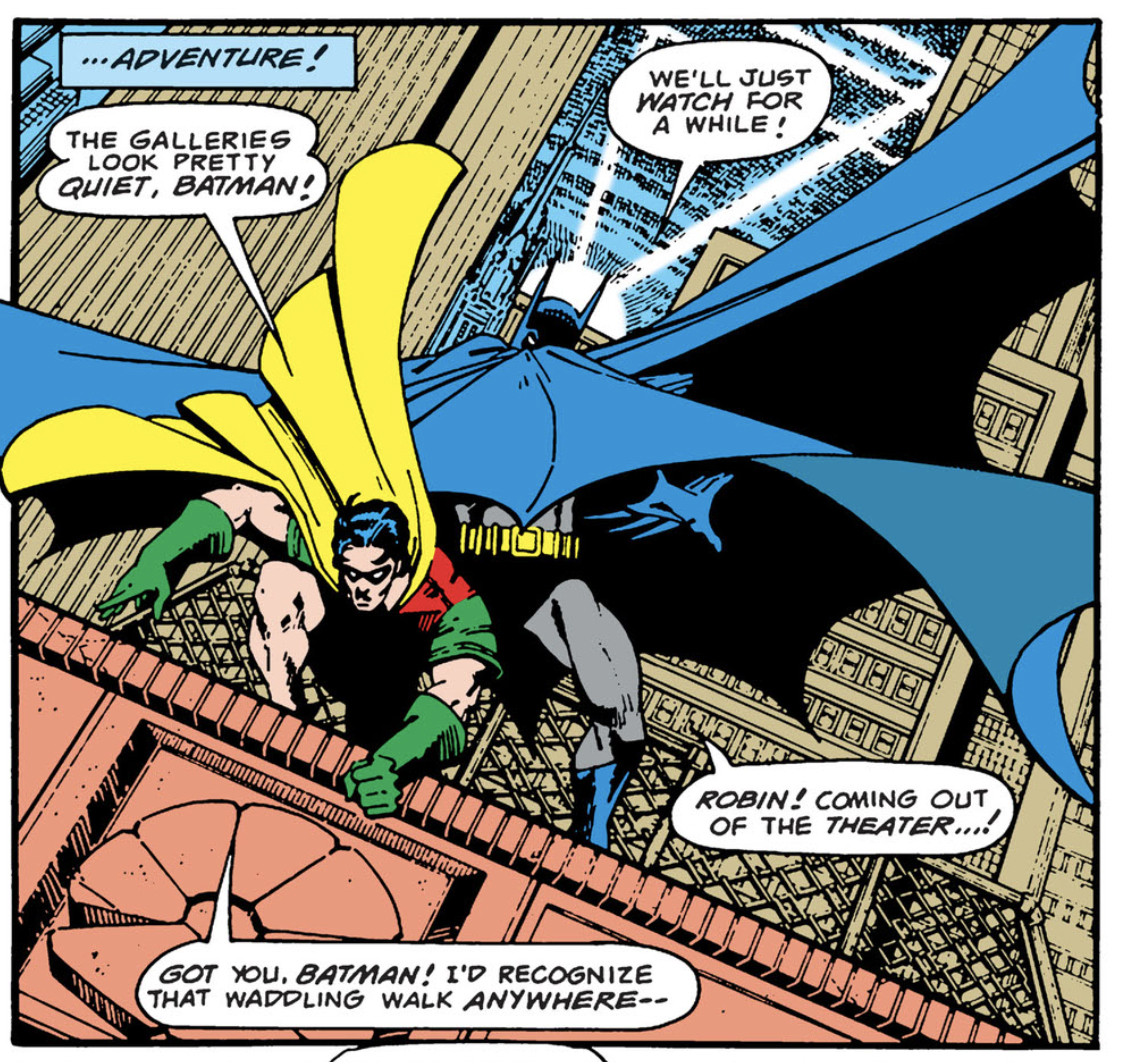
Panel from Detective Comics #473, art by Marshall Rogers and Terry Austin
For me, this image looms large because I saw it advertised in comic ads for Batman: From the ’30s to the ’70s. I never owned that book as a kid (I do now), but I did own a reprint of the poster, found in a box of Post Cereal during one of their many DC Comics promotions in the late ’70s/early ’80s. Even as a small child, I could feel the power this image had. The last word on the enduring partnership of the Dynamic Duo.
—
MORE
— 13 THINGS to Love About BATMAN After 50 Years of Reading Comics. Click here.
— The TOP 13 GREATEST BATMAN STORIES EVER — RANKED. Click here.
—
Chris Franklin is a graphic designer, illustrator, and podcaster, who co-hosts several shows on the Fire and Water Podcast Network, including JLUCast, which he produces with his wife Cindy. Special thanks to Mike Voles of the wonderful Mike’s Amazing World site, for the invaluable indexing that helped shape this article.

March 30, 2023
These images of the Dynamic Duo are super-hot!
March 30, 2023
DC is leaving money on the table by not publishing JLGL’s Style Guide!
March 30, 2023
100% agree with it all. I doff my cowl to you, sir.
March 30, 2023
Love these images and this article. Right now I am finishing up my Visual History of Batman published by DK.
March 30, 2023
Great list! Loved all the examples across time.
October 15, 2024
I saw this at Target and squealed with delight. Definitely the cutest homage I’ve ever seen.
https://www.target.com/p/warner-brothers-batman-and-dc-super-hero-deluxe-comic-soft-book-brave-little-heroes/-/A-89409543#lnk=sametab
October 15, 2024
Absolutely love this! Speaking of being in the Spotlight the 1966 Bat-Movie featured variations on this in the opening credits sequence. When I saw the movie in ’66 I was a little disappointed they didn’t just do the TV opening but I’ve come to realize this is not only an homage but brilliant! And I love Neal Adams’ art for the record cover!